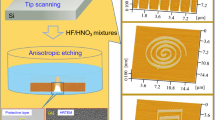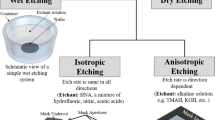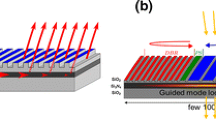Abstract
This paper examines wet and dry fabrication of vertical micro-mirrors in (110) silicon for use in an innovative BioMEMS integrating gripping and micro force sensing functionalities. Wet anisotropic chemical etching in potassium hydroxide (KOH) and tetramethyl ammonium hydroxide (TMAH) with and without isopropanol alcohol (IPA) additive was examined. Deep Reactive Ion Etched samples were produced using inductive coupled process. 3D surface roughness of samples was examined using scanning electron microscope, interferometric profilometer and atomic force microscopy. An optic fiber displacement sensor was exploited to measure the reflectivity of uncoated or coated samples with evaporated metallic thin film. The research aimed to find optimal fabrication technique for fabricating vertical micro-mirrors in polymer based BioMEMS. TMAH etched silicon samples with surface roughness R a = 15.1 nm showed highest reflectivity of all structures fabricated, reflectivity was more than doubled by adding a 10 nm layer of evaporated aluminum coating.











Similar content being viewed by others
References
Agarwal R (2007) Fabrication of vertical mirrors using plasma etch and KOH: IPA polishing. J Micromech Microeng 17(1):26–35
Bashir R (2004) BioMEMS: state-of-the-art in detection, opportunities and prospects. Adv Drug Deliv Rev 56(11):1565–1586
Biswas K, Kal S (2006) Etch characteristics of KOH, TMAH and dual doped TMAH for bulk micromachining of silicon. Microelectron J 37(6):519–525
Craciun G, Blauw MA, Van Der Drift E, Sarro PM, French PJ (2002) Temperature influence on etching deep holes with SF6/O2 cryogenic plasma. J Micromech Microeng 12(4):390–394
Grayson ACR, Shawgo RS, Johnson AM, Flynn NT, Li Y, Cima MJ (2004) A BioMEMS review: MEMS technology for physiologically integrated devices. Proc IEEE 92(1):6–21
Hashim MR, Salih KQ (2005) Optical properties of treated and untreated monocrystalline p-Si <1 1 1>, p-Si <1 0 0>, n-Si <1 1 1> and n-Si <1 0 0> wafers in the visible region at room temperature. Microelectron Eng 81(2–4):243–250
Kendall DL (2003) Vertical Etching of silicon at very high aspect ratios. Annu Rev Mat Sci 9(1):373–403
Mackay RE, Le HR (2008) Development of micro-tweezers for tissue micro-manipulation. In: Proceedings of the 2nd International Conference on Bioinformatics and Biomedical Engineering, pp 1551–1554, Shanghai, China, 2008
Mackay RE, Le HR, Keatch RP (2011) Design optimization and fabrication of SU-8 based electro-thermal micro-grippers. J Micro/Nano Mechatron 6(1–2):13–22
Marxer C, Thio C, Gretillat MA, de Rooij NF, Battig R, Anthamatten O (1997) Vertical mirrors fabricated by deep reactive ion etching for fiber-optic switching applications. J Microelectromech Syst 6(3):277–285
Matsunaga T, Esashi M (2002) Acceleration switch with extended holding time using squeeze film effect for side airbag systems. Sens Actuators A Phys 100(1):10–17
Palik ED, Gray HF, Klein PB (1983) A Raman study of etching silicon in aqueous KOH. J Electrochem Soc 130(4):956–959
Powell O (2001) Anisotropic etching of 100 and 110 planes in (100) silicon. J Micromech Microeng 11(3):217–220
Price JB (1973) Anisotropic etching of silicon with KOH–H2O–isopropyl alcohol. In: Huff HR, Burgess RR (eds) Semiconductor silicon. Princeton, NJ, pp 339–353
Sato K, Shikidaa M, Yamashiroa T, Tsunekawaa M, Itob S (1999a) Roughening of single-crystal silicon surface etched by KOH water solution. Sens Actuators A 73(1–2):122–130
Sato K, Shikidaa M, Yamashiroa T, Asaumi K, Iriye Y, Yamamoto M (1999b) Anisotropic etching rates of single-crystal silicon for TMAH water solution as a function of crystallographic orientation. Sens Actuators A 73(1–2):131–137
Seidel H, Csepregi L, Heuberger A, Baumgartel H (1990) Anisotropic etching of crystalline silicon in alkaline solutions. J Electrochem Soc 137(11):3612–3626
Suresh S (2007) Biomechanics and biophysics of cancer cells. Acta Biomater 3(4):413–438
Williams KR, Muller RS (1996) Etch rates for micromachining processing. J Microelectromech Syst 5(4):256–269
Yang CR, Chen PY, Chiou YC, Lee RT (2005) Effects of mechanical agitation and surfactant additive on silicon anisotropic etching in alkaline KOH solution. Sens Actuators A 119(1):263–270
Yun SS, You SK, Lee JH (2006) Fabrication of vertical optical plane using DRIE and KOH crystalline etching of (1 1 0) silicon wafer. Sens Actuators A 128(2):387–394
Acknowledgments
Financial support of EPSRC and IDB Technologies Ltd. towards a PhD Studentship for R.E.M. is acknowledged. The authors would like to express gratitude to Dr Camelia Dunare at the SMC, University of Edinburgh for providing DRIE samples; Dr Robert Keatch for constructive discussions; Martin Kierans for help provided using the SEM and Dr Gary Callon for general support in the cleanroom at University of Dundee. Finally, Mark Rainer for help provided using the Zygo interferometer at the University of Cambridge.
Author information
Authors and Affiliations
Corresponding author
Rights and permissions
About this article
Cite this article
Mackay, R.E., Lionis, N. & Le, H.R. 3D surface topography and reflectivity of anisotropic etched silicon micromirrors for BioMEMS. Microsyst Technol 17, 1763–1770 (2011). https://doi.org/10.1007/s00542-011-1362-3
Received:
Accepted:
Published:
Issue Date:
DOI: https://doi.org/10.1007/s00542-011-1362-3




